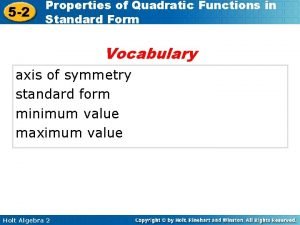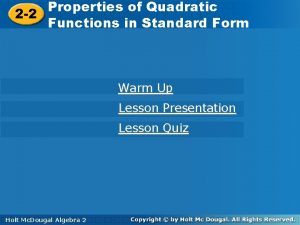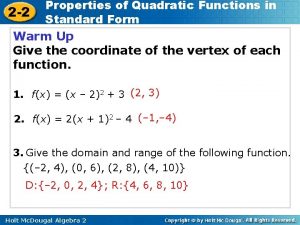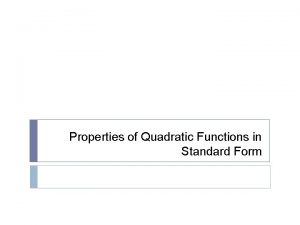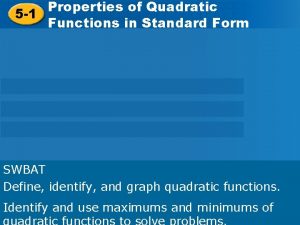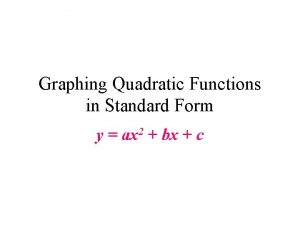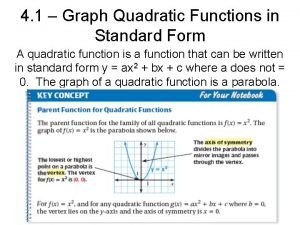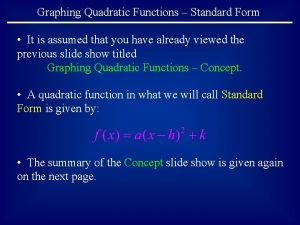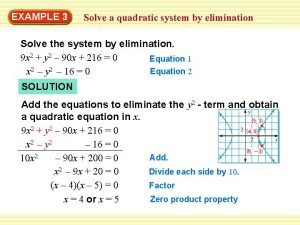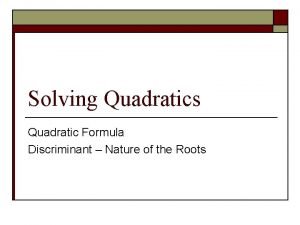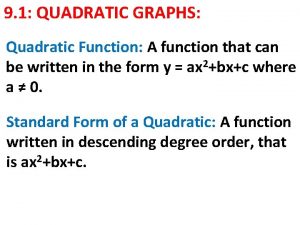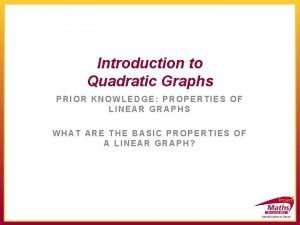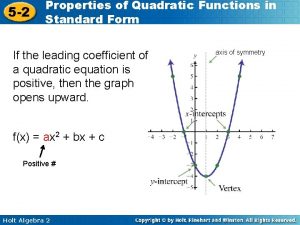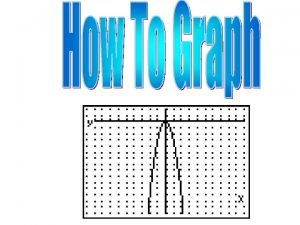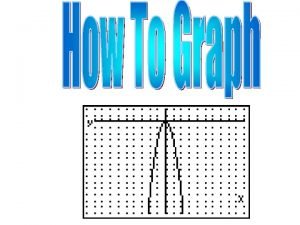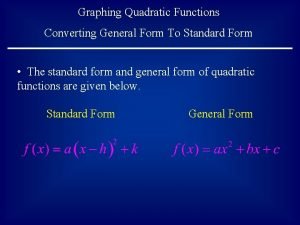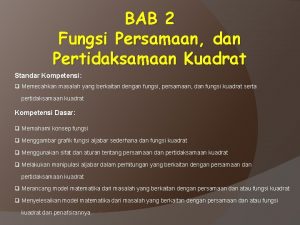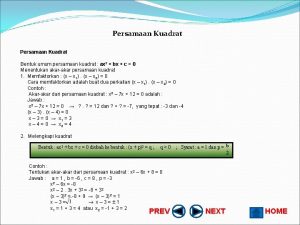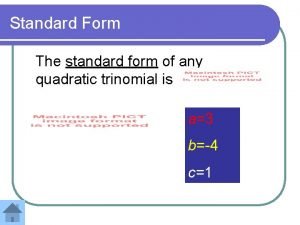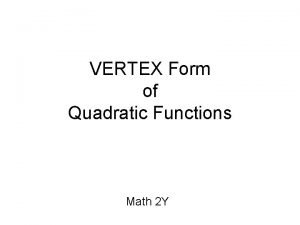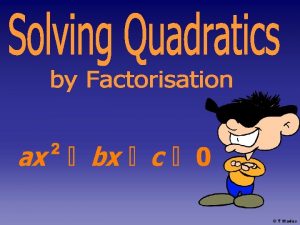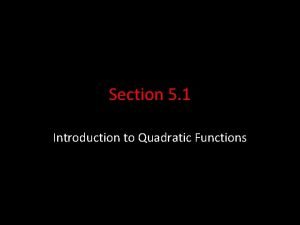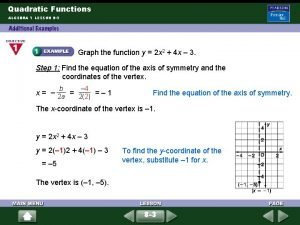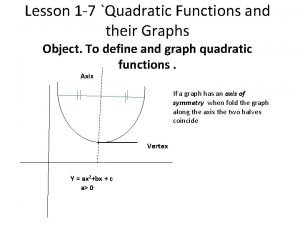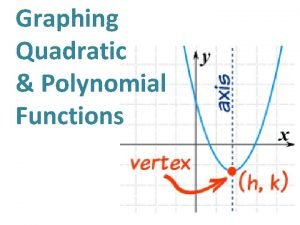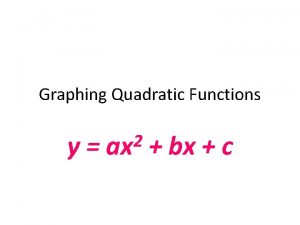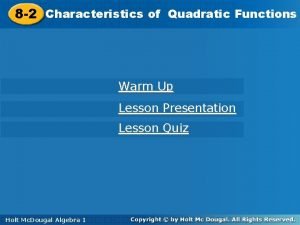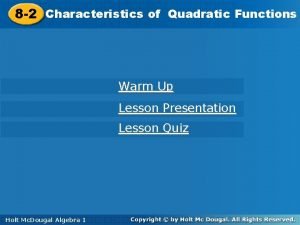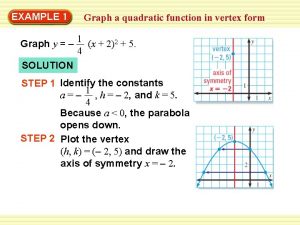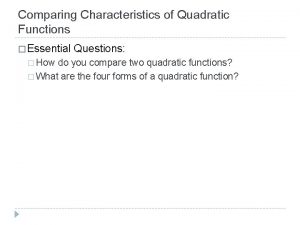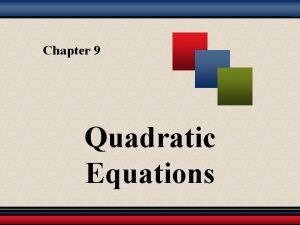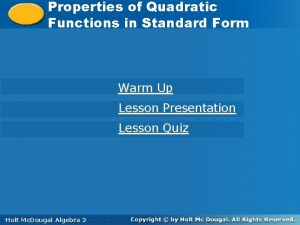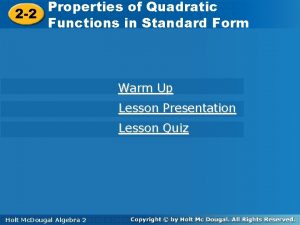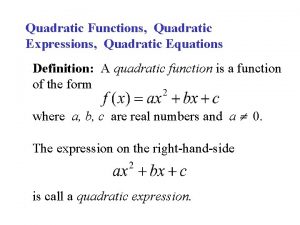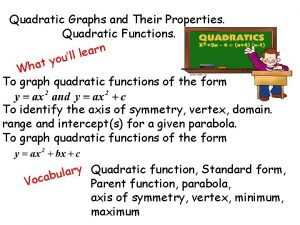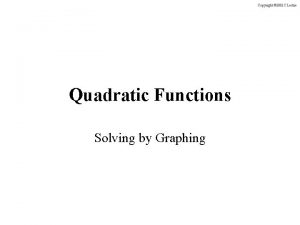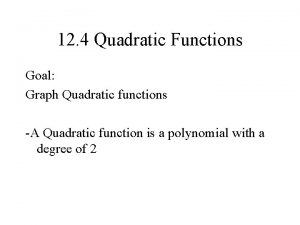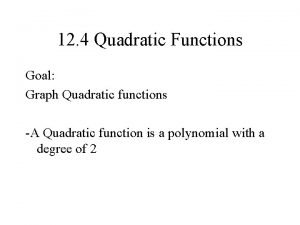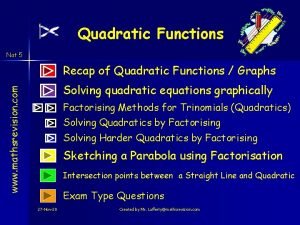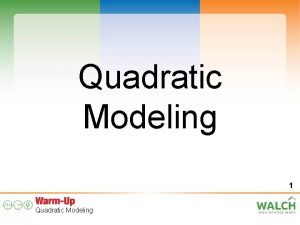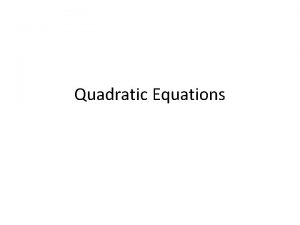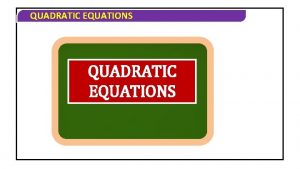Properties of Quadratic Functions in 2 2 Standard












































- Slides: 44

Properties of Quadratic Functions in 2 -2 Standard Form Warm Up Give the coordinate of the vertex of each function. 1. f(x) = (x – 2)2 + 3 (2, 3) 2. f(x) = 2(x + 1)2 – 4 (– 1, – 4) 3. Give the domain and range of the following function. {(– 2, 4), (0, 6), (2, 8), (4, 10)} D: {– 2, 0, 2, 4}; R: {4, 6, 8, 10} Holt Mc. Dougal Algebra 2

2 -2 Properties of Quadratic Functions in Standard Form Objectives Define, identify, and graph quadratic functions. Identify and use maximums and minimums of quadratic functions to solve problems. Holt Mc. Dougal Algebra 2

2 -2 Properties of Quadratic Functions in Standard Form Vocabulary axis of symmetry standard form minimum value maximum value Holt Mc. Dougal Algebra 2

2 -2 Properties of Quadratic Functions in Standard Form When you transformed quadratic functions in the previous lesson, you saw that reflecting the parent function across the y-axis results in the same function. Holt Mc. Dougal Algebra 2

2 -2 Properties of Quadratic Functions in Standard Form This shows that parabolas are symmetric curves. The axis of symmetry is the line through the vertex of a parabola that divides the parabola into two congruent halves. Holt Mc. Dougal Algebra 2

2 -2 Properties of Quadratic Functions in Standard Form Example 1: Identifying the Axis of Symmetry Identify the axis of symmetry for the graph of. Rewrite the function to find the value of h. Because h = – 5, the axis of symmetry is the vertical line x = – 5. Holt Mc. Dougal Algebra 2

2 -2 Properties of Quadratic Functions in Standard Form Example 1 Continued Check Analyze the graph on a graphing calculator. The parabola is symmetric about the vertical line x = – 5. Holt Mc. Dougal Algebra 2

2 -2 Properties of Quadratic Functions in Standard Form Team Huddle Identify the axis of symmetry for the graph of Rewrite the function to find the value of h. f(x) = [x - (3)]2 + 1 Because h = 3, the axis of symmetry is the vertical line x = 3. Holt Mc. Dougal Algebra 2

2 -2 Properties of Quadratic Functions in Standard Form Team Huddle Check Analyze the graph on a graphing calculator. The parabola is symmetric about the vertical line x = 3. Holt Mc. Dougal Algebra 2

2 -2 Properties of Quadratic Functions in Standard Form The standard form of a quadratic function is f(x)= ax 2 + bx + c, where a ≠ 0 The coefficients a, b, and c can show properties of the graph of the function. You can determine these properties by expanding the vertex form. f(x)= a(x – h)2 + k f(x)= a(x 2 – 2 xh +h 2) + k Multiply to expand (x – h)2. f(x)= a(x 2) – a(2 hx) + a(h 2) + k Distribute a. f(x)= ax 2 + (– 2 ah)x + (ah 2 + k) Simplify and group terms. Holt Mc. Dougal Algebra 2

2 -2 a=a Properties of Quadratic Functions in Standard Form a in standard form is the same as in vertex form. It indicates whether a reflection and/or vertical stretch or compression has been applied. Holt Mc. Dougal Algebra 2

2 -2 Properties of Quadratic Functions in Standard Form b =– 2 ah Solving for h gives . Therefore, the axis of symmetry, x = h, for a quadratic function in standard form is Holt Mc. Dougal Algebra 2 .

2 -2 Properties of Quadratic Functions in Standard Form Notice that the value of c is the same value form of f when x = 0: c = ah 2 + k given by the vertex f(0) = a(0 – h)2 + k = ah 2 + k. So c is the yintercept. Holt Mc. Dougal Algebra 2

2 -2 Properties of Quadratic Functions in Standard Form These properties can be generalized to help you graph quadratic functions. Holt Mc. Dougal Algebra 2

2 -2 Properties of Quadratic Functions in Standard Form Helpful Hint When a is positive, the parabola is happy (U). When the a negative, the parabola is sad ( ). U Holt Mc. Dougal Algebra 2

2 -2 Properties of Quadratic Functions in Standard Form Example 2 A: Graphing Quadratic Functions in Standard Form Consider the function f(x) = 2 x 2 – 4 x + 5. a. Determine whether the graph opens upward or downward. Because a is positive, the parabola opens upward. b. Find the axis of symmetry. The axis of symmetry is given by Substitute – 4 for b and 2 for a. The axis of symmetry is the line x = 1. Holt Mc. Dougal Algebra 2 .

2 -2 Properties of Quadratic Functions in Standard Form Example 2 A: Graphing Quadratic Functions in Standard Form Consider the function f(x) = 2 x 2 – 4 x + 5. c. Find the vertex. The vertex lies on the axis of symmetry, so the x-coordinate is 1. The y-coordinate is the value of the function at this x-value, or f(1) = 2(1)2 – 4(1) + 5 = 3 The vertex is (1, 3). d. Find the y-intercept. Because c = 5, the intercept is 5. Holt Mc. Dougal Algebra 2

2 -2 Properties of Quadratic Functions in Standard Form Example 2 A: Graphing Quadratic Functions in Standard Form Consider the function f(x) = 2 x 2 – 4 x + 5. e. Graph the function. Holt Mc. Dougal Algebra 2

2 -2 Properties of Quadratic Functions in Standard Form Example 2 B: Graphing Quadratic Functions in Standard Form Consider the function f(x) = –x 2 – 2 x + 3. a. Determine whether the graph opens upward or downward. Because a is negative, the parabola opens downward. b. Find the axis of symmetry. The axis of symmetry is given by . Substitute – 2 for b and – 1 for a. The axis of symmetry is the line x = – 1. Holt Mc. Dougal Algebra 2

2 -2 Properties of Quadratic Functions in Standard Form Example 2 B: Graphing Quadratic Functions in Standard Form Consider the function f(x) = –x 2 – 2 x + 3. c. Find the vertex. The vertex lies on the axis of symmetry, so the x -coordinate is – 1. The y-coordinate is the value of the function at this x-value, or f(– 1) = –(– 1)2 – 2(– 1) + 3 = 4 The vertex is (– 1, 4). d. Find the y-intercept. Because c = 3, the y-intercept is 3. Holt Mc. Dougal Algebra 2

2 -2 Properties of Quadratic Functions in Standard Form Example 2 B: Graphing Quadratic Functions in Standard Form Consider the function f(x) = –x 2 – 2 x + 3. e. Graph the function. Holt Mc. Dougal Algebra 2

2 -2 Properties of Quadratic Functions in Standard Form Team Huddle For the function, (a) determine whether the graph opens upward or downward, (b) find the axis of symmetry, (c) find the vertex, (d) find the y-intercept, and (e) graph the function. f(x)= – 2 x 2 – 4 x a. Because a is negative, the parabola opens downward. b. The axis of symmetry is given by . Substitute – 4 for b and – 2 for a. The axis of symmetry is the line x = – 1. Holt Mc. Dougal Algebra 2

2 -2 Properties of Quadratic Functions in Standard Form Team Huddle f(x)= – 2 x 2 – 4 x c. The vertex lies on the axis of symmetry, so the x-coordinate is – 1. The y-coordinate is the value of the function at this x-value, or f(– 1) = – 2(– 1)2 – 4(– 1) = 2 The vertex is (– 1, 2). d. Because c is 0, the y-intercept is 0. Holt Mc. Dougal Algebra 2

2 -2 Properties of Quadratic Functions in Standard Form Team Huddle f(x)= – 2 x 2 – 4 x e. Graph the function. Holt Mc. Dougal Algebra 2

2 -2 Properties of Quadratic Functions in Standard Form Team Huddle For the function, (a) determine whether the graph opens upward or downward, (b) find the axis of symmetry, (c) find the vertex, (d) find the y-intercept, and (e) graph the function. g(x)= x 2 + 3 x – 1. a. Because a is positive, the parabola opens upward. b. The axis of symmetry is given by . Substitute 3 for b and 1 for a. The axis of symmetry is the line Holt Mc. Dougal Algebra 2 .

2 -2 Properties of Quadratic Functions in Standard Form Team Huddle g(x)= x 2 + 3 x – 1 c. The vertex lies on the axis of symmetry, so the x-coordinate is. The y-coordinate is the value of the function at this x-value, or f( )=( The vertex is ( )2 + 3( , )– 1= ). d. Because c = – 1, the intercept is – 1. Holt Mc. Dougal Algebra 2

2 -2 Properties of Quadratic Functions in Standard Form Team Huddle e. Graph the function. Holt Mc. Dougal Algebra 2

2 -2 Properties of Quadratic Functions in Standard Form Substituting any real value of x into a quadratic equation results in a real number. Therefore, the domain of any quadratic function is all real numbers. The range of a quadratic function depends on its vertex and the direction that the parabola opens. Caution! The minimum (or maximum) value is the y-value at the vertex. It is not the ordered pair that represents the vertex. Holt Mc. Dougal Algebra 2

2 -2 Properties of Quadratic Functions in Standard Form Holt Mc. Dougal Algebra 2

2 -2 Properties of Quadratic Functions in Standard Form Example 3: Finding Minimum or Maximum Values Find the minimum or maximum value of f(x) = – 3 x 2 + 2 x – 4. Then state the domain and range of the function. Step 1 Determine whether the function has minimum or maximum value. Because a is negative, the graph opens downward and has a maximum value. Step 2 Find the x-value of the vertex. Substitute 2 for b and – 3 for a. Holt Mc. Dougal Algebra 2

2 -2 Properties of Quadratic Functions in Standard Form Example 3 Continued Find the minimum or maximum value of f(x) = – 3 x 2 + 2 x – 4. Then state the domain and range of the function. Step 3 Then find the y-value of the vertex, The maximum value is. The domain is all real numbers, R. The range is all real numbers less than or equal to Holt Mc. Dougal Algebra 2

2 -2 Properties of Quadratic Functions in Standard Form Example 3 Continued Check Graph f(x)=– 3 x 2 + 2 x – 4 on a graphing calculator. The graph and table support the answer. Holt Mc. Dougal Algebra 2

2 -2 Properties of Quadratic Functions in Standard Form Team Huddle Find the minimum or maximum value of f(x) = x 2 – 6 x + 3. Then state the domain and range of the function. Step 1 Determine whether the function has minimum or maximum value. Because a is positive, the graph opens upward and has a minimum value. Step 2 Find the x-value of the vertex. Holt Mc. Dougal Algebra 2

2 -2 Properties of Quadratic Functions in Standard Form Team Huddle Find the minimum or maximum value of f(x) = x 2 – 6 x + 3. Then state the domain and range of the function. Step 3 Then find the y-value of the vertex, f(3) = (3)2 – 6(3) + 3 = – 6 The minimum value is – 6. The domain is all real numbers, R. The range is all real numbers greater than or equal to – 6, or {y|y ≥ – 6}. Holt Mc. Dougal Algebra 2

2 -2 Properties of Quadratic Functions in Standard Form Team Huddle Check Graph f(x)=x 2 – 6 x + 3 on a graphing calculator. The graph and table support the answer. Holt Mc. Dougal Algebra 2

2 -2 Properties of Quadratic Functions in Standard Form Team Huddle Find the minimum or maximum value of g(x) = – 2 x 2 – 4. Then state the domain and range of the function. Step 1 Determine whether the function has minimum or maximum value. Because a is negative, the graph opens downward and has a maximum value. Step 2 Find the x-value of the vertex. Holt Mc. Dougal Algebra 2

2 -2 Properties of Quadratic Functions in Standard Form Team Huddle Find the minimum or maximum value of g(x) = – 2 x 2 – 4. Then state the domain and range of the function. Step 3 Then find the y-value of the vertex, f(0) = – 2(0)2 – 4 = – 4 The maximum value is – 4. The domain is all real numbers, R. The range is all real numbers less than or equal to – 4, or {y|y ≤ – 4}. Holt Mc. Dougal Algebra 2

2 -2 Properties of Quadratic Functions in Standard Form Team Huddle Check Graph f(x)=– 2 x 2 – 4 on a graphing calculator. The graph and table support the answer. Holt Mc. Dougal Algebra 2

2 -2 Properties of Quadratic Functions in Standard Form Team Huddle The highway mileage m in miles per gallon for a compact car is approximately by m(s) = – 0. 025 s 2 + 2. 45 s – 30, where s is the speed in miles per hour. What is the maximum mileage for this compact car to the nearest tenth of a mile per gallon? What speed results in this mileage? Holt Mc. Dougal Algebra 2

2 -2 Properties of Quadratic Functions in Standard Form Team Huddle The maximum value will be at the vertex (s, m(s)). Step 1 Find the s-value of the vertex using a = – 0. 025 and b = 2. 45 ) ( b s === 49 2 a 2 (-0. 025) Holt Mc. Dougal Algebra 2

2 -2 Properties of Quadratic Functions in Standard Form Team Huddle Step 2 Substitute this s-value into m to find the corresponding maximum, m(s) = – 0. 025 s 2 + 2. 45 s – 30 Substitute 49 for r. m(49) = – 0. 025(49)2 + 2. 45(49) – 30 m(49) ≈ 30 Use a calculator. The maximum mileage is 30 mi/gal at 49 mi/h. Holt Mc. Dougal Algebra 2

2 -2 Properties of Quadratic Functions in Standard Form Team Huddle Check Graph the function on a graphing calculator. Use the MAXIMUM feature under the CALCULATE menu to approximate the MAXIMUM. The graph supports the answer. Holt Mc. Dougal Algebra 2

2 -2 Properties of Quadratic Functions in Standard Form Team Mastery Consider the function f(x)= 2 x 2 + 6 x – 7. 1. Determine whether the graph opens upward or downward. upward 2. Find the axis of symmetry. x = – 1. 5 3. Find the vertex. (– 1. 5, – 11. 5) 4. Identify the maximum or minimum value of the function. min. : – 11. 5 5. Find the y-intercept. Holt Mc. Dougal Algebra 2 – 7

2 -2 Properties of Quadratic Functions in Standard Form Team Mastery Consider the function f(x)= 2 x 2 + 6 x – 7. 6. Graph the function. 7. Find the domain and range of the function. D: All real numbers; R {y|y ≥ – 11. 5} Holt Mc. Dougal Algebra 2
 Properties of quadratic functions
Properties of quadratic functions Properties of quadratic functions in standard form
Properties of quadratic functions in standard form Standard form of quadratics
Standard form of quadratics Properties of quadratic function
Properties of quadratic function Properties of a quadratic function
Properties of a quadratic function How to find a in vertex form
How to find a in vertex form Properties of quadratic functions
Properties of quadratic functions Graphing quadratic functions standard form
Graphing quadratic functions standard form 4-1 graphing quadratic functions
4-1 graphing quadratic functions How to graph quadratic functions in standard form
How to graph quadratic functions in standard form Solving quadratic systems by elimination
Solving quadratic systems by elimination What is the quadratic formula
What is the quadratic formula Quadratic graphs and their properties
Quadratic graphs and their properties Properties of quadratic graphs
Properties of quadratic graphs What is the leading coefficient in a quadratic equation
What is the leading coefficient in a quadratic equation Quadratic formula round to the nearest hundredth calculator
Quadratic formula round to the nearest hundredth calculator What is a standard form of a quadratic equation
What is a standard form of a quadratic equation Standard form of the quadratic equation
Standard form of the quadratic equation Standard form of quadratic equation
Standard form of quadratic equation Quadratic function converter
Quadratic function converter Persamaan dan pertidaksamaan kuadrat
Persamaan dan pertidaksamaan kuadrat Standard form equation
Standard form equation Quadratic trinomial in standard form
Quadratic trinomial in standard form Function form in math
Function form in math Using transformations to graph quadratic functions
Using transformations to graph quadratic functions Graph using transformations
Graph using transformations Facts about quadratic functions
Facts about quadratic functions Graphsketch
Graphsketch Introduction to quadratic function
Introduction to quadratic function Is a parabola linear or exponential
Is a parabola linear or exponential Quadratic function maximum
Quadratic function maximum 8-3 graphing quadratic functions
8-3 graphing quadratic functions Quadratic formula vocabulary words
Quadratic formula vocabulary words 9-3 practice transformations of quadratic functions
9-3 practice transformations of quadratic functions Quadratic functions and their graphs
Quadratic functions and their graphs Crime scene factoring and quadratic functions answer key
Crime scene factoring and quadratic functions answer key Lesson 8 extra practice quadratic functions
Lesson 8 extra practice quadratic functions Graphing of polynomial function
Graphing of polynomial function How to find the y intercept of a parabola
How to find the y intercept of a parabola Sketch graph of quadratic function
Sketch graph of quadratic function 8-2 quadratic functions
8-2 quadratic functions 8-2 lesson quiz quadratic functions in vertex form
8-2 lesson quiz quadratic functions in vertex form How do you solve for a in vertex form
How do you solve for a in vertex form Comparing quadratic functions
Comparing quadratic functions Chapter 9 quadratic equations and functions
Chapter 9 quadratic equations and functions

